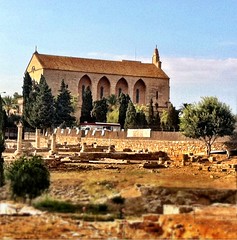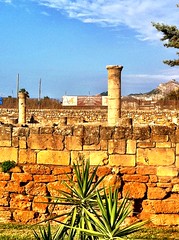Roman City Of Pollentia
Introduction to the Consorci de Pollentia.
At the end of the year 2000 the Collaboration Frame Agreement was signed by the Balearic Government, the Consell de Mallorca and Alcúdia Town Council in order to establish the Roman City of Pollèntia Consortium.
At the same time they signed the statues governing and determining the philosophy of the Consortium. As expressed in item 2 “The aim of the Consortium is to extend, maintain, conserve, restore, protect and inform about the archaeological remains of the ancient Roman city of Pollèntia, located in the city of Alcúdia, which envisages all those activities promoting the culture and knowledge of our past”.
Introduction to the foundations.
The foundation of Pollèntia, following the conquest of the island by the consul Qintus Caecilius Metellus in 123 BCE, signified the beginning of urban life in Mallorca.
Pol·lèntia Underwent a large urban development between and the 1st century BCE and the 3rd century CE, partially because it’s strategic location between the bays of Alcudia. It became the most important city in the Balearics during the Roman Period, with an area between 15 and 20 hectares.
The net-like urban layout, with a north-south orientation, determined the structure of the city, which included drinking water and sewage systems. The theatre, the forum and the residential neighbourhood of La Portella are the three areas open to the public.
Since 2000 the consorci de la Ciutat Romana de Pol·lèntia is in charge of ensuring the conservation, protection and communication of the site.
Area of Portella:
La Portella is the residential area, containing remains of three domus and the road layout connecting them.
The house if the Two Treasures is the best preserved domus. Here the visitors can observe the different parts of the structure, arranged around the atrium, Its main façade looks out onto carrer Porticat (arcaded stret), where the columns that supported the arcade are still preserved.
The house of the Bronze Head is located on the exact opposite side of the street. The Head of the Girl, exhibited in the museum, was found inside the house. The Northwest House is the least well preserved but a selection of the 3rd century CE Roman wall can be found on it’s foundations.
Area of the Forum:
The remains of the Forum, the city square, are situated in the centre of Pol·lèntia.
The area was opened to the public in 2002. At present archaeological work continues in the area during the summer months.
This site has yielded valuable information about the urban layout of Pol·lèntia. It is a chronological record that spans from the foundation of the city in the 1st century BCE to a later period linked with a vast necropolis.
The most significant elements are the Capitolium temple, two small minor temples, a large set of abernae (commercial area), as well as several ornamental elements.
Area of the Theatre:
The Roman Theatre (1st century CE) is situated on the outskirts of the city and this completes the archaeological site.
The excavations by the Bryant Foundation (1953) uncovered the theatre structure with its three different sections: the cavea, of semicircular shape and cut in the rock, seated the audience; the orchestra also of semicircular shape; and the escena, of rectangular shape, where the actors performed.
In the late Roman period the theatre was used as a necropolis. Trapezoidal burial holed excavated in the cavea and escena can still be identified.
The Museum:
To round off your visit to Pollèntia go to the Museu Monogràfic de Pol·lèntia, where you will enjoy an exhibition of the of objects found during the excavation campaigns.
The Museum is situated in the historic centre of Alcúdia (c/Sant Jaume, 30) very close to the Church of Sant Jaume, a 14th century building.
The Museum was redesigned in the summer of 2006. The two sections: the private everyday object exhibition which includes cooking implements, crockery tableware, as well as jewellery and gamerelated objects. The public exhibition which is divided into three areas: public life in the Forum, illustrated by large-scale sculptures, inscriptions or architectural elements; spectacles and the funerary world.
| Opening Hours: | ||
|





No Comments